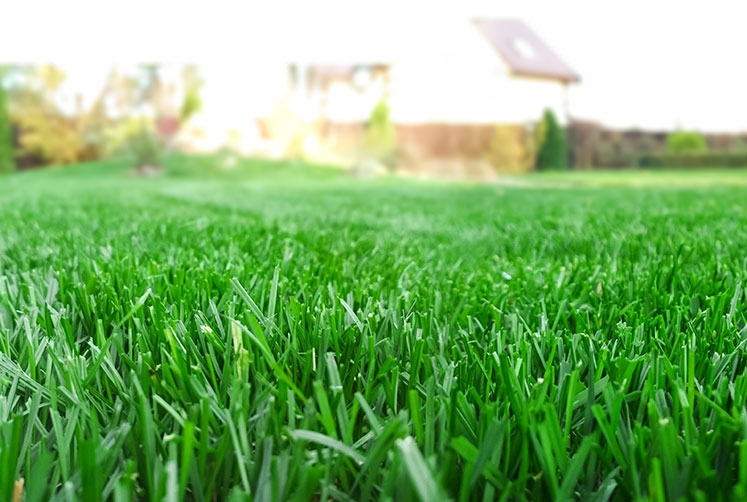
Steam these days seems like a quaint relic of the early industrial age when people travelled by locomotive, not something so high-tech as to be paired with artificial intelligence and robotics.
Yet that’s just what Mark Boysen decided to do when he sought to replace herbicides in lawncare with a more environmentally friendly alternative. For his efforts at combining the two unlikely technologies, his Edina-based startup, Naware, recently took the $10,000 Green and Sustainable Chemistry Prize, sponsored by the MPCA as part of the MN Cup.
How it works
Naware (pronounced En-aware), which Boysen currently runs out of his garage, produces a robotics platform that mounts onto existing equipment—like a mower, tractor, or ATV—and uses artificial intelligence (AI) technology to detect weeds and spray them with hot steam, both killing the weeds while cutting grass. A water tank attachment can be adjusted for any yard job—Boysen estimates that two gallons of water is enough to cover one acre.
“Our mission is to remove toxic chemicals from lawns and turf using 100% water,” Boysen said.
The AI ensures that only weeds get a blast of the hot steam. Nozzles with cameras and steam jets identify weeds as the lawn mower moves. The precision targeting technology uses only steam to eradicate weeds in about 20 minutes.
Naware’s chief marketing officer, Barbara Baldwin, says to think of it like ChatGPT.
“We train AI to distinguish weeds versus healthy grass using images, and we built an AI model to create the weed detection software,” Baldwin said.
Training the model takes time and requires AI engineers to show the model thousands of pictures of weeds so the machine doesn’t mistake the grass for weeds. Now the AI can detect weeds in real-time with 85% to 90% accuracy.
Though the mower attachment uses hot steam to target weeds, anyone operating the mower sits far enough away from the steam jets to avoid feeling the heat coming off the attachment.
“When we’ve met with clients, they’ve noted how pleasantly surprised they were at how safe it was,” Boysen said.
Safety is a major sticking point for Boysen, whose concern over the dangers of herbicides led him to come up with a weed-killing alternative.
The problem with herbicides
Herbicides present a known danger, not just to human health, but to the environment as well. Runoff from herbicides decreases water quality, causing excess nutrients that lead to algal blooms, and can contribute to fish kills and contaminated groundwater.
We unknowingly bring herbicides into our homes after walking around in a park with grass treated with herbicides, or from kids playing on a soccer field or other turf. Pets often roll in herbicide-treated grass and then hop up on the couch, leaving traces of the chemicals in the home.
“Herbicides show up in a variety of ways,” Baldwin said. “So, it’s important to me that we put a product out into the market that is safe for people, pets, and the planet.”
Boysen has a personal concern with herbicides. His family of farmers in rural North Dakota lost five loved ones to cancer, which Boysen attributes to heavy herbicide use on the farm.
“It’s those kinds of data points that kind of brought us to the point of saying ‘there has got to be a better way,’” Boysen said.
Boysen got to thinking about his own lawn, which at the time was taken over by his neighbor's creeping charlie. He had experienced painful headaches after spraying the yard and decided that he was fed up with using herbicides, so he began testing out new ways to eradicate weeds.
“We first considered shooting lasers from drones,” Boysen said. Though as fanciful and futuristic as that sounds, the team determined that lasers on a dry lawn created too much of a fire danger.
Next, Boysen attempted to use a hand-held garment steamer on the lawn, then the team tried a cryogenic method of freezing the weeds, and then a mix of both lasers and steam. In the end, the steam proved to be the most effective method of killing weeds.
Because Naware only uses water to accomplish something that often requires toxic chemicals, the company was an appealing candidate for this year’s Green and Sustainable Chemistry Prize.

Winning criteria
To be considered for the Green and Sustainable Chemistry Prize, a company’s technology must demonstrate safer or more sustainable chemistry than other products on the market that perform the same function. In Naware’s case, the company swaps steam for herbicides, making a safer and more sustainable alternative.
Technologies must follow one or more of the 12 green chemistry principles created by the American Chemical Society.
MPCA’s green and safer product chemistry coordinator, Peder Sandhei, serves on a panel that selects prize winners based on this criterion every year. Naware’s goal to remove herbicides from the weed-killing process stood out to him.
“Something that eliminates the use of chemicals is as green as you can get,” Sandhei said.
Last year’s winner, Revitri, produces foam-structured glass beads that can increase the range of electric vehicles, improve energy efficiency in newly built homes, and reduce the product costs of plastic components.
The future of Naware
Money from the Green and Sustainable Chemistry Prize will help Naware cover some of the costs that come with introducing an invention to the market, like lawyers and patents in particular.
The company has started to pitch the product to potential investors. As of now, the company’s target audience includes customers with large areas of grass to cover, like parks, golf courses, and soccer fields.
Like other companies just getting started, Naware hopes to get the word out about its product and how it can change the lawn care game.
“We’re really trying to create a product that changes the game here, and being recognized by MPCA, that’s a big deal for us,” Boysen said.
